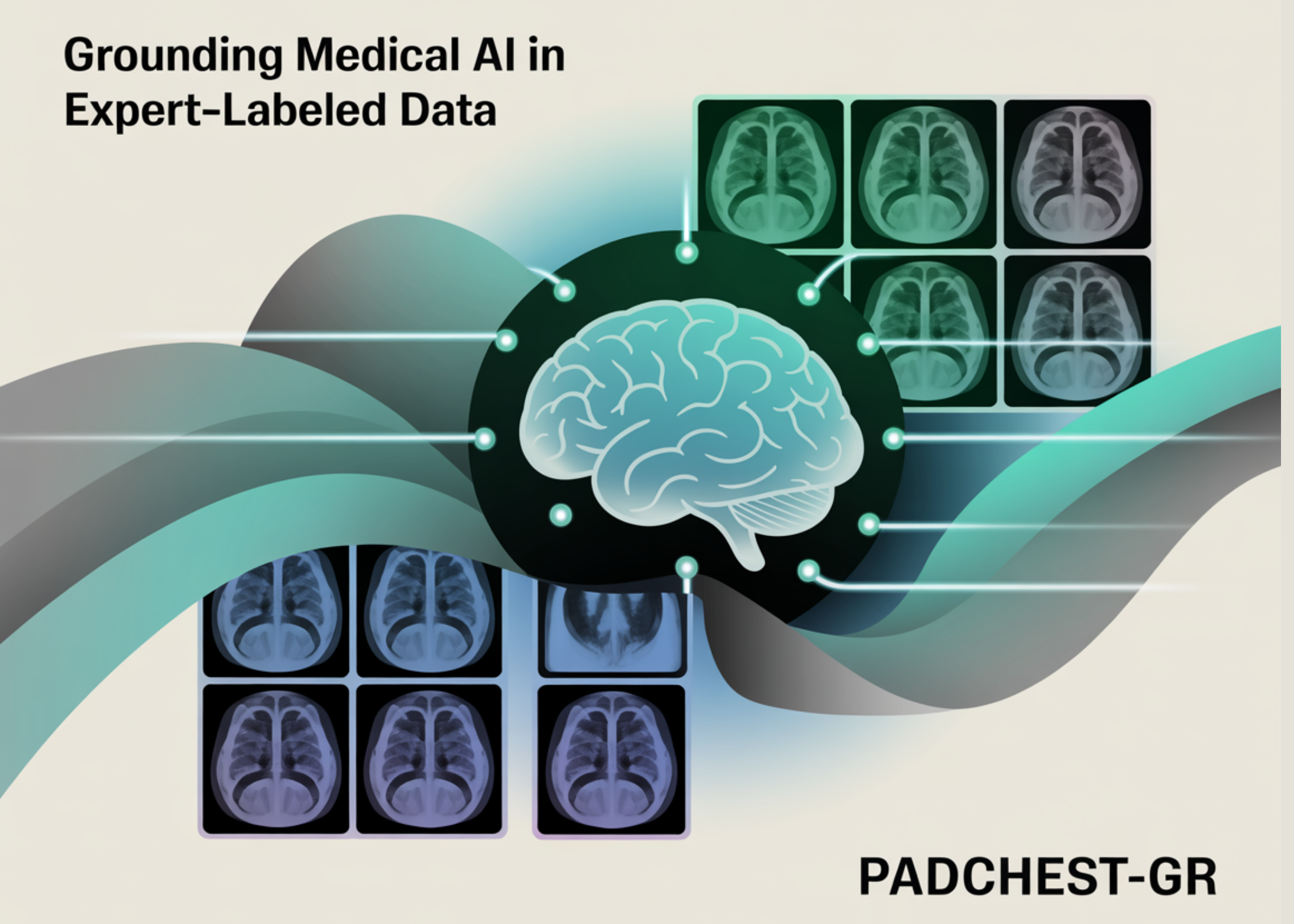Table of contents
A Multimodal Radiology Breakthrough
Introduction
Recent advances in medical AI have underscored that breakthroughs hinge not solely on model sophistication, but fundamentally on the quality and richness of the underlying data. This case study spotlights a pioneering collaboration among Centaur.ai, Microsoft Research, and the University of Alicante, culminating in PadChest‑GR—the first multimodal, bilingual, sentence‑level dataset for grounded radiology reporting. By aligning structured clinical text with annotated chest‑X‑ray imagery, PadChest‑GR empowers models to justify each diagnostic claim with a visually interpretable reference—an innovation that marks a critical leap in AI transparency and trustworthiness.
The Challenge: Moving Beyond Image Classification
Historically, medical imaging datasets have supported only image‑level classification. For example, an X‑ray might be labeled as “showing cardiomegaly” or “no abnormalities detected.” While functional, such classifications fall short on explanation and reliability. AI models trained in this manner are prone to hallucinations—generating unsupported findings or failing to localize pathology accurately .
Enter grounded radiology reporting. This approach demands a richer, dual‑dimensional annotation:
- Spatial grounding: Findings are localized with bounding boxes on the image.
- Linguistic grounding: Each textual description is tied to a specific region, rather than generic classification.
- Contextual clarity: Each report entry is deeply contextualized both linguistically and spatially, greatly reducing ambiguity and raising interpretability.
This paradigm shift requires a fundamentally different kind of dataset—one that embraces complexity, precision, and linguistic nuance.
Human‑in‑the‑Loop at Clinical Scale
Creating PadChest‑GR required uncompromising annotation quality. Centaur.ai’s HIPAA‑compliant labeling platform enabled trained radiologists at the University of Alicante to:
- Draw bounding boxes around visible pathologies in thousands of chest X‑rays.
- Link each region to specific sentence‑level findings, in both Spanish and English.
- Conduct rigorous, consensus‑driven quality control, including adjudication of edge cases and alignment across languages.
Centaur.ai’s platform is purpose‑built for medical‑grade annotation workflows. Its standout features include:
- Multiple annotator consensus & disagreement resolution
- Performance‑weighted labeling (where expert annotations are weighted based on historical agreement)
- Support for DICOM formats and other complex medical imaging types
- Multimodal workflows that handle images, text, and clinical metadata
- Full audit trails, version control, and live quality monitoring—for traceable, trustworthy labels .
These capabilities allowed the research team to focus on challenging medical nuances without sacrificing annotation speed or integrity.
The Dataset: PadChest‑GR
PadChest‑GR builds on the original PadChest dataset by adding these robust dimensions of spatial grounding and bilingual, sentence‑level text alignment .
Key Features:
- Multimodal: Integrates image data (chest X‑rays) with textual observations, precisely aligned.
- Bilingual: Captures annotations in both Spanish and English, broadening utility and inclusivity.
- Sentence‑level granularity: Each finding is connected to a specific sentence, not just a general label.
- Visual explainability: The model can point to exactly where a diagnosis is made, fostering transparency.
By combining these attributes, PadChest‑GR stands as a landmark dataset—reshaping what radiology‑trained AI models can achieve.
Outcomes and Implications
Enhanced Interpretability & Reliability
Grounded annotation enables models to point to the exact region prompting a finding, marvelously improving transparency. Clinicians can see both the claim and its spatial basis—boosting trust.
Reduction of AI Hallucinations
By tying linguistic claims to visual evidence, PadChest‑GR greatly diminishes the risk of fabricated or speculative model outputs.
Bilingual Utility
Multilingual annotations extend the dataset’s applicability across Spanish‑speaking populations, enhancing accessibility and global research potential.
Scalable, High‑Quality Annotation
Combining expert radiologists, stringent consensus, and a secure platform allowed the team to generate complex multimodal annotations at scale, with uncompromised quality.
Broader Reflections: Why Data Matters in Medical AI
This case study is a powerful testament to a broader truth: the future of AI depends on better data, not just better models . Especially in healthcare, where stakes are high and trust is essential, AI’s value is tightly bound to the fidelity of its foundation.
The success of PadChest‑GR hinges on the synergy of:
- Domain experts (radiologists) who bring nuanced judgment.
- Advanced annotation infrastructure (Centaur.ai‘s platform) enabling traceable, consensus-driven workflows.
- Collaborative partnerships (involving Microsoft Research and the University of Alicante), ensuring scientific, linguistic, and technical rigor.
Case Study in Context: Centaur.ai’s Broader Vision
While this study centers on radiology, it exemplifies Centaur.ai‘s wider mission: to scale expert‑level annotation for medical AI across modalities.
- Through their DiagnosUs app, Centaur Labs (the same organization) has built a gamified annotation platform, harnessing collective intelligence and performance‑weighted scoring to label medical data at scale, with speed and accuracy .
- Their platform is HIPAA‑ and SOC 2‑compliant, supporting annotators across image, text, audio, and video data—and serving clients such as Mayo Clinic spin‑outs, pharmaceutical firms, and AI developers .
- Innovations like performance‑weighted labeling help ensure that only high‑performing experts influence the final annotations—raising quality and reliability .
PadChest‑GR sits squarely within this ecosystem—leveraging Centaur.ai’s sophisticated tools and rigorous workflows to deliver a groundbreaking radiology dataset.
Conclusion
The PadChest‑GR case study exemplifies how expert‑grounded, multimodal annotation can fundamentally transform medical AI—enabling transparent, reliable, and linguistically rich diagnostic modeling.
By harnessing domain expertise, multilingual alignment, and spatial grounding, Centaur.ai, Microsoft Research, and the University of Alicante have set a new benchmark for what medical image datasets can—and should—be. Their achievement underscores the vital truth that the promise of AI in healthcare is only as strong as the data it’s trained on.
This case stands as a compelling model for future medical AI collaborations—highlighting the path forward to trustworthy, interpretable, and scalable AI in the clinic. For more information, visit Centaur.ai.
Thanks to the Centaur.ai team for the thought leadership/ Resources for this article. Centaur.ai team has supported and sponsored this content/article.
The post Grounding Medical AI in Expert‑Labeled Data: A Case Study on PadChest-GR- the First Multimodal, Bilingual, Sentence‑Level Dataset for Radiology Reporting appeared first on MarkTechPost.


